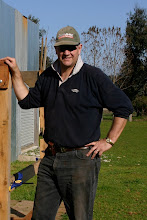I'm in London at present (for Board meetings) and took the opportunity to attend the final day of the Chelsea Flower Show. The Concierge at my excellent hotel did what concierges are supposed to do and found me a ticket.
It was only a short taxi ride and I was there soon after gates opened at 8am. What can I say ... in the main it is very English - so it was lovely. But the things that really caught my eye were not, in the end, English at all. The first was a garden called 'After the Fire'. Until I looked just now I didn't realise that it was an award winner - but ... there you go. The first thing I noticed was what looked to me like a plant that grows on my roadside at Moora Farm. I know it as Black Wattle. The lady I talked to said it was Acacia Dealbata - which Wikipedia describes at a Silver Wattle.
So it was after an Australian fire? Well no actually - the people are from Mediterranean France - and the wattle is an import there. The garden was still reminiscent of home - and beautiful. There was some sort of a tie up with a Cancer charity involved and the parallel was drawn between after a wildfire - and after Chemotheraphy. Which made me think of good friends dealing with that challenge at present.
The other highlight for me was meeting a man called Jaap Sneeboer - the owner of a Dutch company that makes traditional hand forged garden tools. Two or three weeks ago I was in a little town called Trentham - not far from my home in Australia. I found a little shop called Phillip&Lea that, it turned out, had only opened that very day. It sells a slightly eccentric mix of cooking equipment and gardening tools - with the gardening part of the range being ... Sneeboer hand tools. I bought a beautiful hand weeder for a not unreasonable price - given its quality and functionality.
I was able to tell Jaap the story and hear a little of his.
He has just put out a new form of a Dutch hoe - which he calls a Royal Dutch Hoe. I seriously covet one! It's not only the hand forged tool head - but the handle is great as well. Being made by Dutchmen the handle on the standard how was almost long enough for me - but Jaap said they had a longer handle still. I gotta get one!
I'm particularly interested in hoes at present - because I'm growing a crop for stock feed called Fodder Beet (or Mangel Wurzel) My Dad grew it in the 1960s for a few years and they produce a large beet (several kilos) - which is a very nutritious cattle feed - though in what combination with hay or other dry food I am yet to find out.
I planted several small areas totalling perhaps a quarter of an acre in March and early April. The first photo is of one of the WWOOFers (Alex) doing the fairly laborious job of the first thin.
The seeds come in small clumps naturally - and so after about 3 weeks it is necessary to thin them to about 3 inches apart. When they are fully grown the spacing will need to be more like 6 to even 12 inches - but I'm intrigued by the capacity to 'take a yield' along the way to feed to chickens or sheep - which will be mainly tops as opposed to the root dominance there will be later on.
The second photo shows two more WWOOFers (Ashleigh and Lisa) weeding the same fodder beet after they have been growing for nearly 2 months. They now are at the stage where a further thinning can be fed out.
The interest in hoes comes from the thinning and weeding tasks. I remember when I weeded fodder beet for my Dad it was with a home made triangular headed hoe. If I remember correctly, he was most pleased with himself and thought it better than the available alternatives.
I already have a variety of hoes - but none that seems to do the job better than bending one's back and hand weeding. I'm hoping that a Royal Dutch Hoe will make a difference.
Depending on how this autumn planted crop produces, I may grow more over time. I suspect it can help me fill both my summer and winter 'feed gaps'. This crop will be ready (I hope) during winter or very early spring. If I plant another crop in (say) November - It would help deal with the late summer grass growth slowdown.
The stock definitely need to be trained to it. They don't rush it at the moment - not like our pigs did in the 60s - and others have told me cattle will once they get the taste for it.
I also don't think I'd do it without the WWOOFer help - as thinning and weeding is hard work. But I'm not asking you to do anything I haven't done guys!






No comments:
Post a Comment